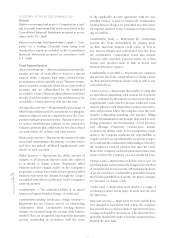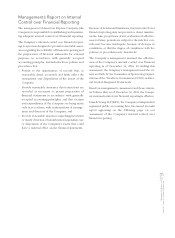American Express 2004 Annual Report Download - page 74
Download and view the complete annual report
Please find page 74 of the 2004 American Express annual report below. You can navigate through the pages in the report by either clicking on the pages listed below, or by using the keyword search tool below to find specific information within the annual report.
“plan,” “aim,” “will,” “may,” “should,” “could,” “would,”
“likely,” and similar expressions are intended to identify
forward-looking statements. Readers are cautioned
not to place undue reliance on these forward-looking
statements, which speak only as of the date on which
they are made. The Company undertakes no obligation
to update or revise any forward-looking statements. Fac-
tors that could cause actual results to differ materially
from these forward-looking statements include, but are
not limited to, the following: the Company’s ability to
complete the planned spin-off of its AEFA business unit,
which is subject to final approval by the Company’s
Board of Directors, the receipt of necessary regulatory
approvals and a favorable tax ruling and/or opinion,
and in connection with the proposed spin-off, the
Company’s ability to implement effective transition
arrangements with AEFA on a post-completion basis; the
Company’s ability to grow its business and meet or
exceed its return on shareholders’ equity target by rein-
vesting approximately 35% of annually-generated capi-
tal, and returning approximately 65% of such capital to
shareholders, over time, which will depend on the Com-
pany’s ability to manage its capital needs and the effect
of business mix, acquisitions and rating agency require-
ments; consumer and business spending on the Compa-
ny’s travel related services products, particularly credit
and charge cards and Travelers Cheques and other pre-
paid products and growth in card lending balances,
which depend in part on the ability to issue new and
enhanced card and prepaid products and increase rev-
enues from such products, attract new cardmembers,
reduce cardmember attrition, capture a greater share of
existing cardmembers’ spending, sustain premium dis-
count rates on its card products in light of market pres-
sures, increase merchant coverage, retain cardmembers
after low introductory lending rates have expired, and
expand the global network services (GNS) business; the
success of the GNS business in partnering with banks in
the United States, which will depend in part on the
extent to which such business further enhances the
Company’s brand, allows the Company to leverage its
significant processing scale, expands merchant cover-
age of the network, provides U.S. GNS bank partners the
benefits of greater cardmember loyalty and higher
spend per customer, and merchant benefits such as
greater transaction volume and additional higher spend-
ing customers; the continuation of favorable trends,
including increased travel and entertainment spending
and the overall level of consumer confidence; success-
fully cross-selling financial, travel, card and other prod-
ucts and services to the Company’s customer base, both
in the United States and abroad; the Company’s ability
to generate sufficient revenues for expanded investment
spending, and the ability to capitalize on such
investments to improve business metrics; the costs and
integration of acquisitions; the success, timeliness and
financial impact, including costs, cost savings and other
benefits including increased revenues, and beneficial
effect on the Company’s operating expense to revenue
ratio both in the short-term and over time, of reengineer-
ing initiatives being implemented or considered by the
Company, including cost management, structural and
strategic measures such as vendor, process, facilities and
operations consolidation, outsourcing (including,
among others, technologies operations), relocating cer-
tain functions to lower-cost overseas locations, moving
internal and external functions to the Internet to save
costs, and planned staff reductions relating to certain of
such reengineering actions; the ability to control and
manage operating, infrastructure, advertising and pro-
motion expenses as business expands or changes,
including the ability to accurately estimate the provision
for the cost of the Membership Rewards program; the
Company’s ability to manage credit risk related to con-
sumer debt, business loans, merchant bankruptcies and
other credit trends and the rate of bankruptcies, which
can affect spending on card products, debt payments by
individual and corporate customers and businesses that
accept the Company’s card products and returns on the
Company’s investment portfolios; bankruptcies, restruc-
turings or similar events affecting the airline or any other
industry representing a significant portion of TRS’ billed
business, including any potential negative effect on par-
ticular card products and services and billed business
generally that could result from the actual or perceived
weakness of key business partners in such industries;
the triggering of obligations to make payments to certain
co-brand partners, merchants, vendors and customers
under contractual arrangements with such parties under
certain circumstances; a downturn in the Company’s
businesses and/or negative changes in the Company’s
and its subsidiaries’ credit ratings, which could result in
contingent payments under contracts, decreased liquid-
ity and higher borrowing costs; risks associated with the
Company’s agreements with Delta Air Lines to prepay
$500 million for the future purchases of Delta Skymiles
rewards points and to loan up to $75 million to Delta;
AEFA’s ability to improve investment performance,
including attracting and retaining high-quality person-
nel, and reduce outflows of invested funds; AEFA’s
ability to develop and introduce new and attractive
products to clients in a timely manner and effectively
manage the economics in selling a growing volume of
non-proprietary mutual funds and other retail financial
AXP
AR.04
72
Financial Review
























